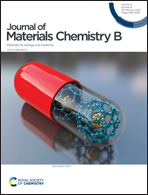A ZIF-8-encapsulated interpenetrated hydrogel/nanofiber composite patch for chronic wound treatment†
Abstract
Designing wound dressings necessitates the crucial considerations of maintaining a moist environment and implementing effective bacterial control. Furthermore, developing a three-dimensional framework emulating the extracellular matrix (ECM) confers advantages in fostering cellular migration and proliferation. Inspired by this, hydrogel/nanofiber composites have been demonstrated as promising materials for wound dressings. The composites also overcome the disadvantages of poor mechanical properties and rapid release of traditional pure hydrogels. In this study, we constructed a calcium alginate hydrogel/polylactic acid nanofiber (CAH/PLANF) composite with an interpenetrated network. Additionally, the synthesis of zeolitic imidazolate framework-8 (ZIF-8) incorporated into the composite system endowed the system with enhanced mechanical properties and photodynamic antibacterial attributes. The obtained composite patch (ZIF-8@CAH/PLANF) exhibited excellent swelling, strong mechanical properties, low cytotoxicity, and durable photodynamic antibacterial effect with an antibacterial efficacy of higher than 99.99%. Finally, bacterial infection and wound healing properties were investigated in vivo, and the ZIF-8@CAH/PLANF patch was proven to have the ability to fight infection and accelerate wound healing.

- This article is part of the themed collections: Functional Framework Materials for Biomedical Applications and 2025 Journal of Materials Chemistry B Chinese New Year


 Please wait while we load your content...
Please wait while we load your content...